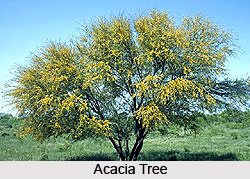 In the Indian subcontinent one of the species of acacia called Acacia Catechu is known as 'Khair'. It is a medium sized deciduous tree with crooked and forked truck. Its growth can be traced in both natural and plantation forms in most parts of the nation up to an elevation of 1300 meters above sea level. In India the Acacia Catechu is categorized mainly into three divisions: Catechu, Catechuoides and Sundra. In India the Acacia Catechu is widely found in Uttar Pradesh, Jammu, Punjab, Himachal Pradesh, Madhya Pradesh, Bihar, Orissa and Andhra Pradesh. The other species known as Acacia Catechuoides is found in the terrain region of Sikkim, West Bengal and Assam whereas the third variety also known as the 'red catechu' or 'lal khair' is prevalent in Gujarat, the Deccan, Rajasthan and southern parts of Maharashtra.
In the Indian subcontinent one of the species of acacia called Acacia Catechu is known as 'Khair'. It is a medium sized deciduous tree with crooked and forked truck. Its growth can be traced in both natural and plantation forms in most parts of the nation up to an elevation of 1300 meters above sea level. In India the Acacia Catechu is categorized mainly into three divisions: Catechu, Catechuoides and Sundra. In India the Acacia Catechu is widely found in Uttar Pradesh, Jammu, Punjab, Himachal Pradesh, Madhya Pradesh, Bihar, Orissa and Andhra Pradesh. The other species known as Acacia Catechuoides is found in the terrain region of Sikkim, West Bengal and Assam whereas the third variety also known as the 'red catechu' or 'lal khair' is prevalent in Gujarat, the Deccan, Rajasthan and southern parts of Maharashtra.Functional uses
- Fodder: Not widely used as fodder, but in India 1-year-old plantations are browsed by cattle. Apiculture: The flowers are a source of pollen for honey production.
- Fuel: A major source of firewood, its dense wood and high energy (calorific value of 4,500–4,900 kilocalories per kilogram (2,000–2,200 kcal/lb)) contribute to its popularity. It provides very good charcoal that glows well with little smoke and does not spark.
- Fibre: The wood is extensively used for paper pulp. Plantation-grown trees have been found promising for the production of unbleached kraft pulp and high-quality, neutral, sulphite semi-chemical pulp. Large-scale plantations have already been established, as in Kerala, India, for the production of pulp.
- Timber: The sapwood is yellow; the heartwood light brown to dark red, straight grained and reasonably durable. The wood has a high basic density (500–650 kilograms per cubic metre (31–41 lb/cu ft)), is fine-grained, often attractively figured and finishes well. It is excellent for turnery articles, toys, carom coins,
No comments:
Post a Comment